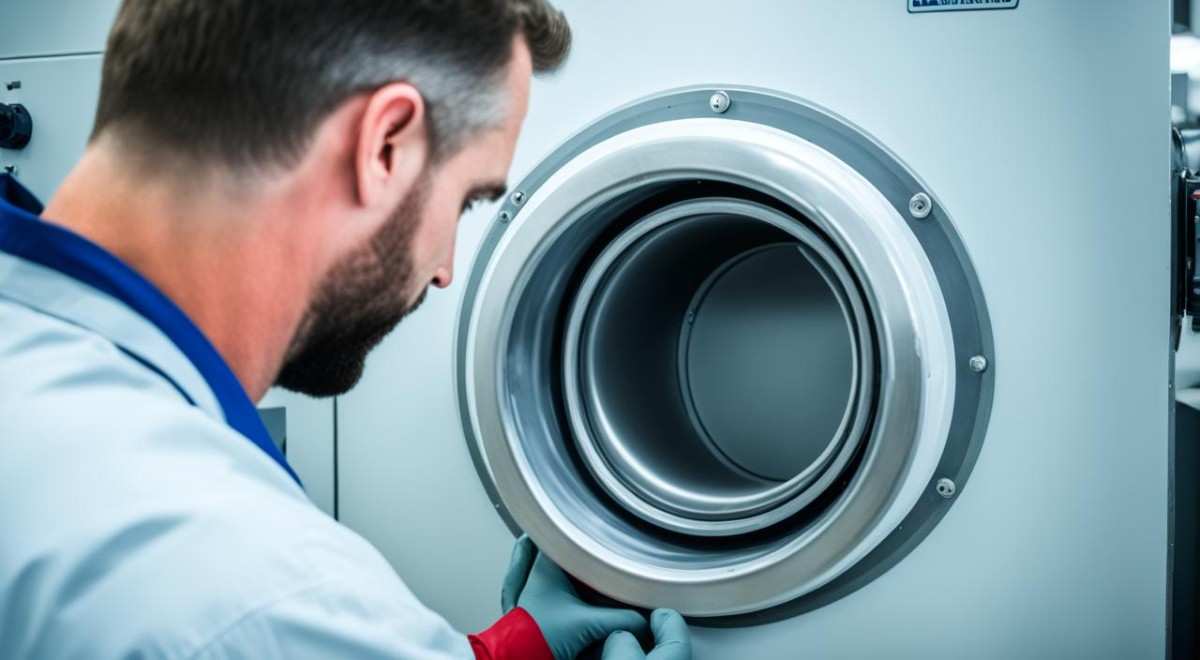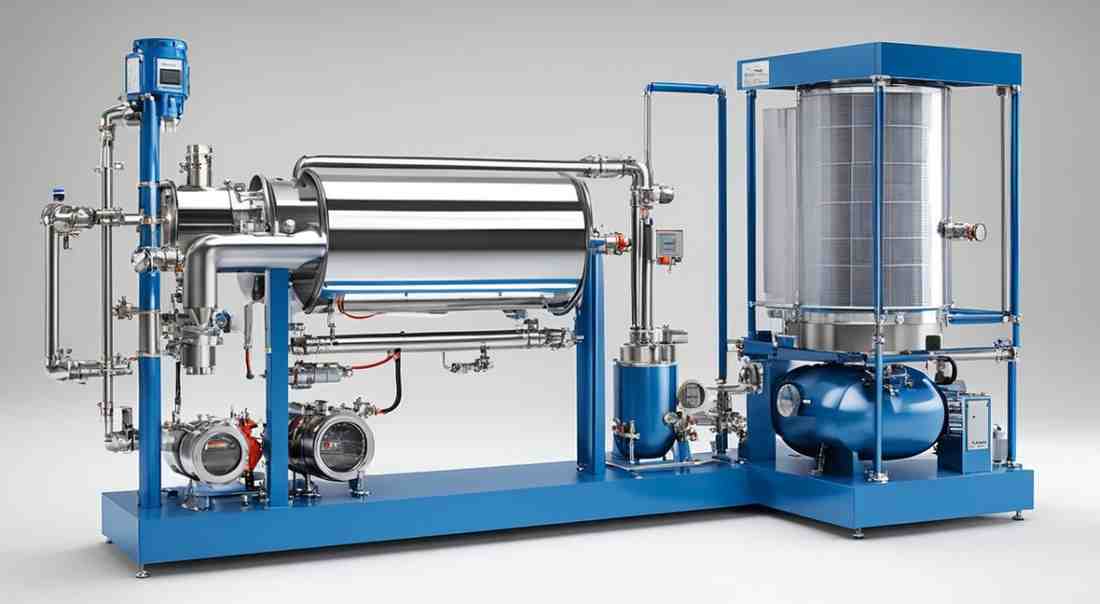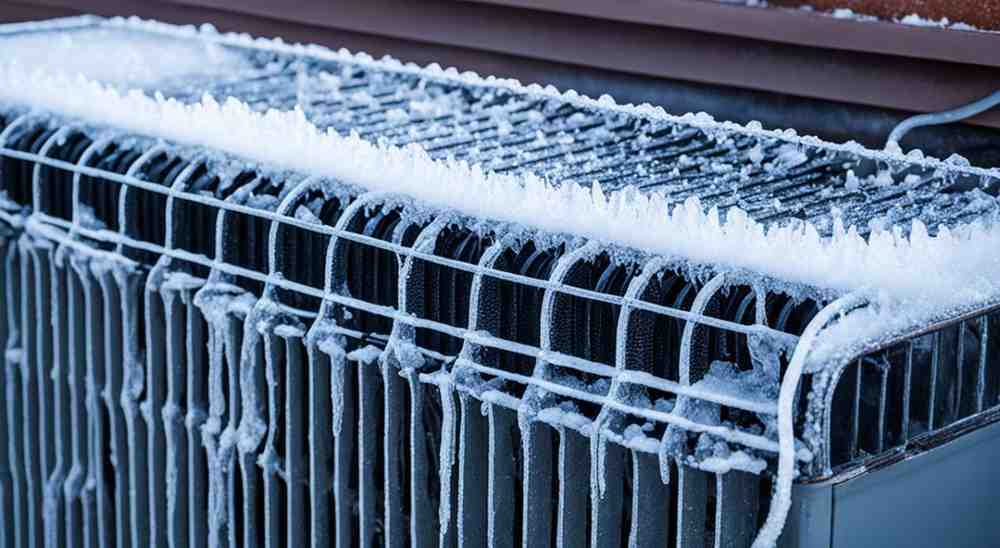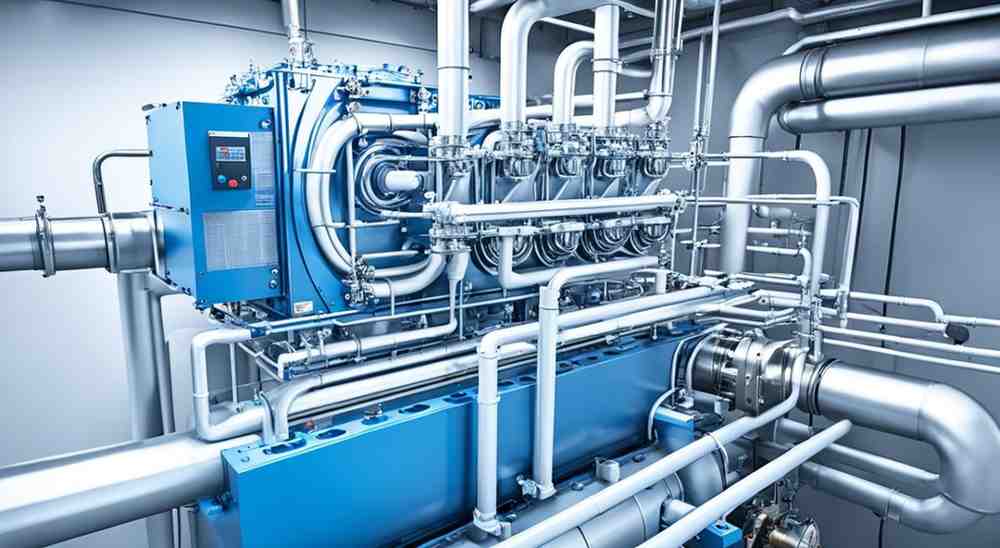Freeze Dryer Troubleshooting: Quick Fixes & Solutions. Did you know the freeze drying market is set to hit $5.3 billion by 2026, growing at 8.2% annually? This shows how crucial it is to keep your freezer in top shape. It ensures your products stay high quality and boosts your output.
This guide will cover the most frequent freeze dryer problems. You’ll learn quick fixes and solutions to keep your gear working well. We’ll show you how to handle vacuum leaks, temperature issues, and other common problems.

Key Takeaways
- Understand the fundamental principles of lyophilization and the key components of a freeze dryer
- Diagnose and resolve vacuum leaks that can compromise product quality and process efficiency
- Identify and fix condenser temperature issues, including refrigeration system failures and defrosting problems
- Troubleshoot heater and temperature control problems, such as improper temperature sensing and heater relay failures
- Optimize your freeze-drying process and address common cycle-related issues
Understanding Freeze Dryer Fundamentals
The freeze dryer is key in many fields, from making medicines to processing food. Knowing how it works is vital for fixing and improving it. This means grasping the freeze dryer fundamentals and lyophilization principles is crucial.
Principles of Lyophilization
Lyophilization, or freeze-drying, removes water from items by turning it into vapor. First, the item is frozen. Then, the pressure drops so the frozen water turns straight to vapor without going liquid. This method maintains the item’s structure and extends its shelf life. It’s used for many products.
Freeze Dryer Components and their Functions
A freeze dryer component and function have important parts that work together for drying:
- Condenser: it captures and holds the water vapor from drying.
- Vacuum System: Lowers the pressure inside the dryer for ice to sublimate.
- Temperature Controls: This Keeps the sample and condenser at the right temperature for drying.
Knowing how these freeze dryer components work helps fix and solve problems in the lyophilization process.

“Freeze drying is a critical process that preserves the quality and stability of many important products. By understanding the fundamentals, you can ensure your freeze dryer operates at its best.”
Vacuum Leak Detection and Resolution
Keeping your vacuum in top shape is key for your freeze dryer’s performance. Vacuum leaks can hurt the efficiency and quality of drying, causing delays and poor results. We’ll look into finding and fixing vacuum leaks to help you solve these problems quickly.
Identifying Vacuum Leaks
First, find where the leak is coming from. Often, it’s due to worn gaskets, cracked seals, or bad connections. Check your freeze dryer’s parts regularly and watch the vacuum levels. This way, you can spot leaks early and stop them from getting worse.
- Do a close check on all seals, gaskets, and connections.
- Use a vacuum leak detector to find where the leak is.
- Listen for hissing or whistling sounds that mean there’s a leak.
Sealing the Leaks
The fix depends on how bad the leak is.
- Swap out any broken gaskets or seals for new ones.
- Think about using a vacuum-safe sealant or lubricant on the problem spots.
Fixing vacuum leaks helps your freeze dryer work better and keeps your drying process consistent and quality.

“Proper vacuum leak detection and resolution is the foundation of a well-functioning freeze dryer.”
| Vacuum Leak Symptoms | Potential Causes | Recommended Solutions |
|---|---|---|
| Inability to reach desired vacuum level | Worn gaskets, cracked seals, and loose connections | Replace gaskets, tighten connections, and apply sealant |
| Fluctuating vacuum readings | Intermittent leaks, faulty vacuum sensors | Inspect system and replace sensors if necessary |
| Sudden loss of vacuum during operation | Major leaks, component failure | Identify and address the source of the leak |
Condenser Temperature Issues: Causes and Solutions
The condenser is key to your freeze dryer’s performance. But issues with its temperature can cause big problems, like refrigeration failures or cooling system failure and defrost cycle issues. It’s important to know what causes these problems and how to fix them to keep your freezer and dryer working well.
Refrigeration System Failures
One big reason for condenser temperature problems is refrigeration system failures. This can happen for many reasons, like low refrigerant, compressor issues, or problems with the condenser coil. Checking and keeping the refrigeration parts in good shape can stop these failures and keep the condenser at the right temperature.
Condenser Defrosting Problems
Another issue is with defrosting the condenser. Moisture from the freeze-drying process can freeze on the condenser coil. If defrosting doesn’t work right, the ice can block heat from being released. This raises the temperature and can cause other problems.
To fix defrosting issues, make sure the defrost cycle is set right and the defrost heater works well. Clean the condenser coil often to keep it running efficiently and stop ice from forming.

Knowing what causes condenser temperature problems, like refrigeration failures and defrost cycle issues, helps you fix them early. Regular maintenance and troubleshooting can prevent expensive downtime and keep your freeze-drying process going smoothly.
Heater and Temperature Control Troubleshooting
Freeze dryers need precise temperature control for successful lyophilization. But you might face heater and temperature control issues. Let’s look at common problems and how to fix them to keep your freezer dryer working well.
Not Sensing Temperature Properly
Getting the temperature right is key for freeze drying. If your freeze dryer can’t sense the temperature, you might see uneven drying or even total failure. This could be from bad temperature sensors or wrong placement. Make sure to check and calibrate your sensors and place them correctly to fix this.
Detecting Too Much Heat: Heater Relay Failure
Too much heat is another big problem. It often comes from a broken heater relay. This part controls the heater’s power. If it breaks, the heater might keep running, causing overheating and damage to your samples. Check the heater relay and replace it if needed to fix this temperature control issue.

Fixing heater malfunctions and temperature sensor problems is key for your freeze dryer’s performance. By knowing the causes and solutions, you can keep your lyophilization processes consistent and reliable.
Freeze Dryer Troubleshooting: Cooling and Refrigeration
Keeping your freeze dryer cool and refrigerated right is key for it to work well. Sometimes, it might not cool enough to start the drying process. Let’s look at why these cooling issues and refrigeration problems happen and how to fix them.
Not Getting Cold Enough
If your freezer can’t cool down as it should, there are a few things to check. First, make sure the refrigeration system is working right. The compressor should be on and the coolant levels should be good. Also, check the condenser for any blockages or icing that could stop cooling.
Also, think about the room’s temperature where the freezer sits. If it’s too warm, the unit might not cool enough. You might need to move it to a cooler spot.
The system won’t Start the drying Process
If your freezer dryer won’t start drying, it could be a cooling or refrigeration problem. Make sure the condenser and refrigeration unit are working properly. If the compressor or other important parts aren’t working, the dry process malfunctions, which can stop the dryer from starting.
Also, check if the unit is warm enough to start drying. If it’s too cold, it won’t start the drying cycle. Fixing the cooling and refrigeration issues should help get the dryer going again.

“Proper cooling and refrigeration are essential for the efficient operation of your freeze dryer. Identifying and resolving issues in these systems can make all the difference in achieving successful lyophilization.”
Vacuum System Troubleshooting
Keeping the right vacuum levels is key to freeze-drying success. But you might face problems like a broken vacuum sensor or trouble reaching the needed vacuum.
Vacuum Sensor Not Working
If your vacuum sensor isn’t giving correct readings, it can mess up the freeze drying. This might be because the sensor is broken, not set right, or there are wiring issues. Here’s how to fix it:
- Look for any damage or wear on the vacuum sensor.
- Check the sensor’s calibration against a trusted vacuum gauge.
- Make sure the wiring between the sensor and control system is okay.
If the sensor is broken, you’ll need a new one for accurate vacuum control.
Unable to Achieve Vacuum
Having trouble reaching the vacuum level you need could be due to vacuum system issues or leaks. First, inspect the vacuum system closely, focusing on:
- Search for cracks, holes, or loose parts in the vacuum lines and connections.
- Do a vacuum leak test to find where the vacuum failure is coming from.
- Make sure the vacuum pump is working right and there are no vacuum sensor problems.
- Check that the condenser is working correctly and not blocking the vacuum.
Fixing the main cause of the vacuum system issues will help get your freeze dryer working smoothly again.
“Good vacuum system maintenance work is the of the successful freeze drying process. Identifying and resolving any vacuum system problem is crucial for consistent, high-quality results.”
Freeze Dryer Troubleshooting: Vacuum Failures
Keeping a steady vacuum is key for freeze dryers to work well. Vacuum issues can cause problems, like not drying properly. Let’s look at common vacuum problems and how to fix them to keep your freezer dryer in top shape.
Inadequate Vacuum
An inadequate vacuum is a big issue. It can stem from leaks, broken pumps, or sensor errors. If the vacuum isn’t strong enough, your product might not dry fully. Here’s what to do:
- Check for leaks around the door seals, gaskets, and connections.
- Make sure the vacuum pump is working properly and pulling strongly.
- Check the vacuum sensor to see if it’s reading correctly and alerting you when needed.
Mid-Batch Vacuum Failure
Mid-batch vacuum failures are also common. They can happen for many reasons, like power outages or increased product steam. If this happens, follow these steps:
- Find out why the vacuum dropped—like a system glitch or more product steam.
- Try to fix the vacuum by restarting the pump or adjusting the product amount.
- See how the failure affects the batch and decide if you can continue or need to start over.
Fixing these vacuum issues helps your freeze dryer work better and keeps the quality of your product high.
| Issue | Possible Causes | Recommended Solutions |
|---|---|---|
| Inadequate Vacuum |
|
|
| Mid-Batch Vacuum Failure |
|
|
Process Optimization and Cycle Troubleshooting
Getting consistent quality and efficient use from your freeze dryer starts with optimizing the process. By adjusting the lyophilization cycle, you can get the most out of your equipment. This means keeping an eye on temperature, pressure, and time during drying. Make changes as needed to get the results you want.
If problems happen during the cycle, you need to troubleshoot. Look at any changes from what’s expected, like changes in condenser temperature or not reaching the vacuum level. Figure out the main cause, whether it’s a broken part or a process issue. Then, fix it to get your freeze dryer working again.
Getting good at optimizing and troubleshooting will help your freezer dryer work better. You’ll make sure your products are always top-notch and use your equipment efficiently. Always be alert, keep track of what you learn, and keep improving your methods for lasting success.
FAQ: Freeze dryer troubleshooting
What are the most common freeze dryer troubleshooting issues?
Common problems include vacuum leaks, issues with the condenser temperature, and heater malfunctions. You might also face cooling failures and vacuum system problems. Knowing these issues can help you fix your freeze dryer quickly.
How can I detect and resolve vacuum leaks in my freezer dryer?
First, inspect the seals, gaskets, and connections for leaks. Use a leak detector or vacuum gauge to find the leak. Then, fix it by replacing seals or tightening connections to get back to the right vacuum level.
What are the common causes of condenser temperature issues?
Condenser temperature problems can stem from refrigeration failures or defrost cycle issues. Malfunctions in the refrigeration system or coolant problems can affect the condenser temperature. Defrost cycle issues, like wrong settings or sensor failures, can also cause problems.
How can I troubleshoot heater and temperature control problems with my freeze dryer?
Start by checking the temperature sensor to see if it’s working right. If it’s not, it might not give accurate readings, causing temperature issues. Heater relay failures can also lead to temperature problems. Replace faulty parts as needed.
What should I do if my freezer dryer is not getting cold enough or won’t start the drying process?
If it’s not cold enough, check the refrigeration system and cooling components for issues. If it won’t start drying, it might be a complex problem like firmware or control system issues. You may need a technician for help.
How can I troubleshoot vacuum system issues in my freezer dryer?
Check the vacuum sensor to make sure it’s working. If it’s not, you won’t get accurate readings. Also, check for leaks, blockages, or pump problems if the vacuum levels are off. Fix these to get the vacuum right for drying.
What should I do if I encounter mid-batch vacuum failures or inadequate vacuum in my freeze dryer?
Mid-batch vacuum failures can mess up the drying process. Make sure seals and connections are tight and sealed well. If the vacuum fails during the cycle, it might be a pump or control system issue. You’ll likely need a technician for help.
How can I optimize the performance and troubleshoot issues in my freeze dryer’s lyophilization cycle?
Review your process settings to make sure they’re right for your needs. Watch the cycle closely and adjust as needed to keep conditions optimal. If you see problems, look into the freeze dryer’s components and systems to find the cause.